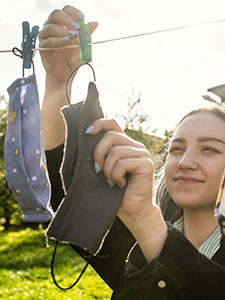POST TAGS
Home DesignBlog posted On March 17, 2021

There’s one day a year that everyone loves to go green. Some think it saves them from a pinch of the skin, while other hope it can lead them to a pot of gold. But with a few simple changes, you can go green every day of the year – right in the comfort of your home – and save a lot more than a pinch.
Free Changes
Play it cool
Heat takes energy. So instead of cranking up your heat at night and pumping the AC during the day, try to ride out the unpredictable Spring and Fall temperatures by adjusting your clothing layers instead of your thermostat. Another way you can conserve energy is by closing vents in the lesser-used rooms of your house. Plus, you can try cooling off your water temperatures too – opting for cold-wash laundry cycles instead. According to the American Cleaning Institute (ACI), about 90% of the energy used by washing machines goes towards heating water.
Wash full loads
We’ve all been there – you’re out of forks and instead of hand washing one or two, you run a dishwasher that’s not even close to being full. Or, you want to wear your favorite shirt, and instead of waiting for a full laundry load, you toss it in with a couple pairs of socks. Though it may not have seemed like a big deal at the time, these little moments add up on your bills.
Hang clothes dry
In most households, the top energy guzzlers are refrigerators, washers, and dryers (in that order). By air-drying your clothes, not only can you help reduce the average household’s carbon footprint, but you can save money, and better protect the fabric of your clothing.
Use the proper stove burners
How often do you just place a pot on the stove in the most convenient place? It’s easy to overlook the different sized burners on a stovetop when you’re in a rush to make dinner, but by placing pots on their proper burners you can more efficiently use heat and save more energy. You might think that the solution is to use bigger burners so that your pot heats faster, but in reality, using burners that are smaller than the size of your pot will help it heat up more effectively.
Low-Cost Changes
Choose energy saving light bulbs
By using Energy Star-certified light bulbs, you can save 70% to 90% more energy than conventional incandescent bulbs. Plus, LED lights last longer – up to 15x longer – than conventional lights bulbs.
Weatherstrip and caulk
Weatherstripping your home is when you seal air leaks around the moving sides of doors and windows. You can weatherstrip with different materials like felt, foam, or vinyl. Metal weatherstripping is a more expensive option but will likely last the longer. For sides of your windows that don’t move, or other small cracks in your house that need extra insulation, you can use caulk to help prevent heat and air conditioning leaks. Caulking and weatherstripping can help cut your energy usage by 25%.
Switch to natural detergents
While many types of conventional laundry detergents might get out the tough stains, they also have synthetical chemical compounds that can be detrimental to water-based ecosystems. When you mix detergent into a load of wash, that dirty water drains out of the laundry machine and into wastewater draining system, that eventually reaches your community’s sanitary sewer system/ wastewater treatment plant. Here, the water is ‘cleaned’ before returning to larger bodies like rivers, lakes, or oceans. However, these plants can’t always remove all of the toxins from detergents, so when the ‘clean’ water returns to the environment, the residual toxins can stimulate an overproduction of algae in the water and ruin the ecosystem (over time). Though natural detergents can be a little more costly, they might be worth considering.
Expensive Changes
Buy energy-efficient appliances
If you’re in need of a new washing machine, dryer, or dishwasher, opt for an Energy Star-certified appliance. According to Natural Resources Canada, their washing machines can use up to 25% less energy and 40% less water than standard models, and their dishwashers can save you 12% on used energy. A new Energy Star dishwasher can save 3,870 gallons of water over its lifetime and can be purchased for as low as roughly $400.
Install ceiling fans and sky lights
Ceiling fans only use a fraction of the energy that air conditioning does. Plus, they can be sold for around $100 and last several years whereas AC can cost $100 in one month. Installing a skylight can be a little more costly – averaging around $1,600 in 2021. However, the more natural light you have in your house, the less electricity you will spend on artificial light inside. A lower-cost solution could be opening more shades during the say as well.
Get savvy bathroom fixtures
Energy efficient shower heads use about 50% less than the typical showerhead. Health experts recommend that you should replace showerheads every few months anyways, so on your next trip to the hardware store, look for the low flow shower heads. Another option for people who like to keep their water pressure strong is a tap aerator – which cuts water usage in half without affecting water pressure. Energy efficient toilets are good options as well, offering you two flush options to save more water when you can.
When it comes to going green, the smallest changes can make the biggest differences – for our planet and your pocket. So, start by doing just one thing. Have any other ideas on how to go green at home?
Sources: Cleaning Institute, Energy Star, Green America, Green America, HGTV, Home Advisor, Home Depot